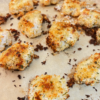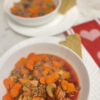
“Hi, I was referred to you because I need help getting started with the FODMAP diet.”
This is how many of my initial emails and phone calls go with my clients who have IBS (Irritable Bowel Syndrome) and other gut issues who are looking for help with the popular FODMAP diet. Many of my clients have been advised to start the seemingly complicated FODMAP diet with a promise that it’ll help their gut issues, but along the way they’re feeling anxious and overwhelmed with how to start. If this feels like you, you’re not alone. Keep reading.
What is the FODMAP diet?
Let’s clarify the diet first. FODMAPS are foods that contain specific short chain fermentable carbohydrates found in many fruits and vegetables, sweeteners, legumes, grains and other foods, and tend to cause or contribute to issues like bloating, gas, diarrhea, constipation and other unfriendly GI symptoms. FODMAPs include foods containing fermentable oligo-saccharides, di and monosaccharides and polyols. Things like lactose, fructose (when in greater amounts than glucose), mannitol, sorbitol, and others. So the FODMAP diet is based on following a plan that is composed of mostly low FODMAP foods, but can include some of the higher FODMAP foods if they don’t contribute to your individual symptoms; sorting out your very own personal foods that REALLY don’t work on that long high FODMAP list is the key.
In general, the FODMAP diet is designed to be a method to identify and help to resolve GI symptoms related to IBS, but certainly isn’t designed to be a long-term solution. So the best way to use it is to adopt it, use it, identify your triggers, then add in the foods that don’t bother you. Sounds easy, right? It’s actually fairly simple but you should use a few key steps to get going.
How to get started?
I find it more helpful and beneficial to start the FODMAP diet in a slower and more manageable way. So I’ve designed a 5 step program to help get on to the diet more easily and with a little less stress (stress isn’t good for GI symptoms!).
First, I recommend to keep a journal or diary of symptoms; if a certain food agrees or disagrees, write it down. If a food on the high FODMAP list (as below) really doesn’t seem to bother you, leave it in, as this diet is limiting enough as it is.
Second, follow my 5 step plan below.
Step 1:Start with eliminating various sweeteners.
Especially if you’re someone who frequents the diet food wagon, you may have these littered throughout your day. Eliminating these various sweeteners includes sugar alcohols, and sugar free items containing polyols (ending in -ol or isomalt). Examples of the sweeteners to avoid include:
- Xylitol
- Maltitol
- Mannitol
- Sorbitol
- Isomalt
- Inulin
Truthfully, aiming to get rid of all artificial sweeteners in general is a good idea, while focused on it. Though maybe not on the high FODMAP list, I find that my clients always do better without many of the artificial sweeteners in general. They’re also not healthful for gut bacteria, which is a key component to gut health (amongst other things). Aim to cut out sweeteners like sucralose, neotame, acesulfame potassium, and aspartame.
Step 2:Eliminate dairy.
One of the major offenders for an upset tummy is lactose- and even “lactose free” foods I find are troublesome as well. Lactose is on the list of high FODMAP foods, and though many of my clients find this difficult, there are plenty of great non dairy alternatives for yogurt and cheese – but be mindful of the items you purchase that may be nondairy yet may have some of the items I recommended to eliminate in step 1.
- Eliminating dairy includes:
- Ice cream
- Cream
- Butter
- All cheeses
- Yogurt
- … anything made with cows milk (sheep’s milk and goats milk may be better though not perfect)
Step 3: Next, eliminate all or most gluten.
Though gluten-containing bread is usually on the low FODMAP list in small quantity I find that many of my clients have just done a lot better without it if they have a sensitive stomach and are working toward a FODMAP diet. The only way to really see if there’s a gluten sensitivity (other than to identify celiac disease) is through experimentation and noting of what seems to work and not work- so be vigilant. Try to choose higher fiber (read the ingredients though!) gluten free breads, as sometimes when people cut out wheat and grains they often cut out a lot of fiber, so make sure to eat more vegetables and a good quality gluten free bread.
Step 4:Alliums:
With any kind of stomach trouble, alliums are classic offenders of gut health and often cause many people a lot of issues with bloating, gas and overall discomfort. Go through frequently consumed foods and work to cut out most or all of the onions and garlic- including seasonings and powders too. Use other seasonings instead- there are so many allowed ones on the low FODMAP list. This is a big one!
Step 5:Personalize it.
If you haven’t found success yet in feeling better and you’re at step 5, it’s time to keep track of what you eat for a few days at least, and go through your inventory. Make a list of commonly consumed foods and systematically work through the list, go slowly as this will help with easier identification. Here’s a few to start with (especially if these are consumed in excess of any kind!)
- alcohol (beer and wine mostly)
- fruits (apples, avocado, melons)
- beans (kidney beans, baked beans, mung beans, lima beans- see the list for more)
Make sure to move through slowly and go food by food (or a few foods at a time instead of all at once)- it makes the process much easier to identify. Additionally, make sure to include healthful foods from the low FODMAP list, especially vegetables- as this is really key for getting enough fiber and vitamins and minerals that can be healing and health promoting.
Of course, if you’re having trouble reach out for help, to your doctor and/or dietitian. This process can be overwhelming and we’re here to help!







